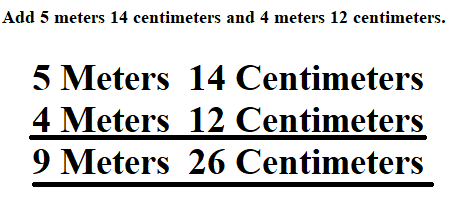Addition and subtraction are the basics of maths that everyone has to learn. We know that there are different units of measurements. In this article, we are going to learn about the addition and subtraction of units of measurement.
Students who are willing to know the concept of addition and subtraction of units of measurement deeply can access this page for free. Here we have to add or subtract two equal or unequal units of measurement. 5th Grade Students will find it easy to understand the concept what we are trying to explain with the help of examples.
Do Refer: Multiplication and Division of Units of Measurement
How to Add and Subtract Units of Measurement?
1. The sum, difference of units of measurement are similar to the common addition and subtraction.
2. You can only add or subtract the measurements when the units are the same.
3. If the units are different then you have to convert them into the same units and then perform the operations.

Adding and Subtracting Units of Measurement Examples
Go through the problems given below and try to solve them to test your knowledge.
Example 1.
Add 6 meters 7 decimal meters and 12 meters and 6 decimal meters?
Solution:
Given,
we can add the units of measurement like decimal numbers.
6 meters 7 decimal meters = 6.7 meters
12 meters 6 decimal meters = 12.6 meters
6.7 meters + 12.6 meters = 19.3 meters
Therefore 19.3 meters = 19 meters 3 decimal meters.
Example 2.
Add 67 kilometers 250 meters and 17 kilometers 120 meters?
Solution:
Given,
67 kilometres 250 meters = 67.250 kilometres
17 kilometres 120 meters = 17.120 kilometres
67.250 kilometres + 17.120 kilometres =84.370 kilometres
Therefore 84.370 kilometres = 24 kilometres 370 meters
Example 3.
Subtract 180 liters 720 milliliters and 100 liters 70 milliliters?
Solution:
Given,
180 litres 720 millilitres = 180.720 litres
100 liters 70 millilitres = 100.70 litres
180.720 litres – 100.70 litres = 80.650 litres
Therefore 80.650 litres = 80 litres 650 millilitres.
Example 4.
The height of the water bottle X is 243 centimeters and that of water bottle Y is 78 centimeters less. What is the height of water bottle Y?
Solution:
Given,
The height of the water bottle X = 243 centimeters
The height of Water bottle Y is 78 centimeters less than water bottle X.
Therefore the height of water bottle Y = 243 – 78 = 165 centimetres
Hence the height of Water bottle Y = 165 centimeters
Example 5.
Subtract 120 kilometers 140 meters from 70 kilometers 10 meters?
Solution:
Given,
120 kilometres 140 meters = 120.140 meters
70 kilometres 10 meters = 70. 10 kilometres
120.140 kilometres – 70.10 kilometres = 50.130 kilometres
Therefore 50.130 kilometres = 50 kilometres 130 meters.
FAQs on Addition and Subtraction of Units of Measurement
1. How do you add metric units?
Metric measures are added in the same way as we add ordinary numbers. We arrange the digits in columns and then add them as required.
2. What are the 7 basic units of measurement?
The 7 basic units of measurements are length, time, mole, electric current, temperature, luminous intensity, mass.
3. Can we add and subtract units of measurement?
Yes of course you can add or subtract the units of measurements by converting them into the same units.
